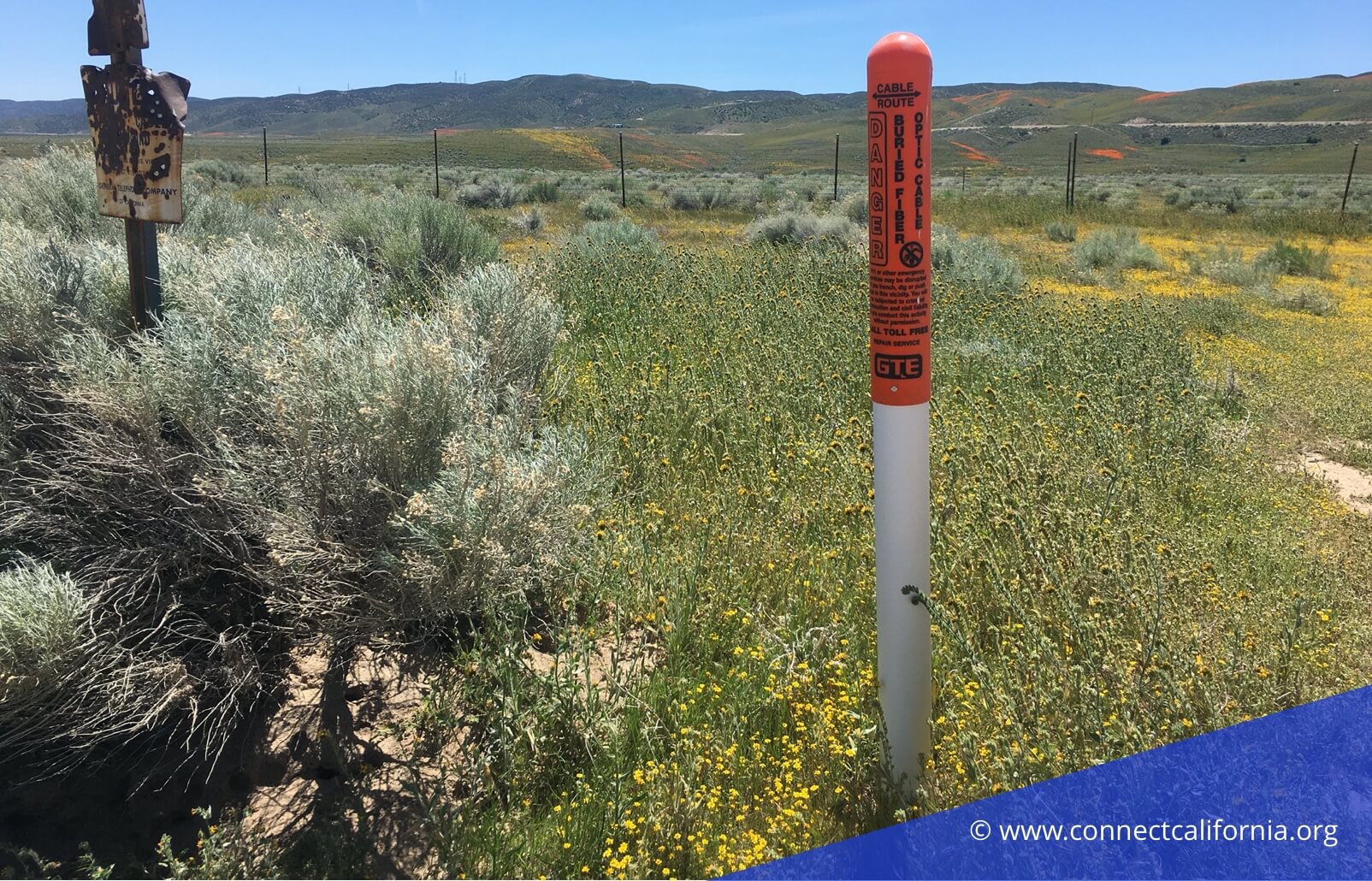There are 17 municipal broadband providers in California as of 2024.
Only 6 of the 17 municipal broadband providers in California offer residential services. Among those, only 3 offer FTTH (Fiber to the Home) service in the last mile. The rest focus on enterprise and business services, or are exclusive to municipal services and anchor institutions like hospitals, libraries, and schools.
The majority of municipal broadband networks in California are based in dark fiber owned by the city. Only 2 of the 17 municipal providers in California are utility co-ops: Connect Anza, and Plumas-Sierra Telecommunications.
While growth of municipal broadband has been slow in California, there are no state laws discouraging the practice. Some other states, such as Texas, have actively discouraged the trend with state policy.
There are 332 total municipal broadband networks in the US, with only 19% of networks nationally offering Fiber to the Home internet service for residential use. 1
Municipal broadband is typically introduced as a solution to serve areas with poor private networks, or where incumbent pricing from providers like Xfinity or Spectrum is unaffordable to residents.
Researching this topic for an article or project? Contact the author for custom insights and commentary on municipal broadband, state infrastructure regulation and the digital divide.
Contact: research@connectcalifornia.com

California Municipal Broadband Providers Summary
| Provider | Network Type | Services Offered |
|---|---|---|
| Beverly Hills Fiber | Fiber | Residential FTTH, Enterprise. (Network under development.) |
| Burbank Water and Power | Enterprise Services, Dark Fiber | Enterprise, Anchor institutions and municipal buildings. |
| City of Anaheim | Fiber, Dark Fiber | Anchor institutions and municipal buildings. |
| City of Shafter, California | Fiber | Enterprise, Anchor institutions and municipal buildings. |
| Connect Anza | Fiber | Residential FTTH, Enterprise, Anchor institutions and municipal buildings. |
| Culver Connect | Fiber | Enterprise, Anchor institutions and municipal buildings. |
| Glendale | Dark Fiber | Anchor institutions and municipal buildings. |
| Loma Linda Connected Community | Fiber | Residential FTTH, Enterprise, Anchor institutions and municipal buildings. |
| Long Beach | Dark Fiber | Anchor institutions and municipal buildings. |
| Palo Alto Fiber | Fiber, Dark Fiber | Enterprise, Anchor institutions and municipal buildings. |
| Pasadena | Fiber, Dark Fiber | Enterprise, Anchor institutions and municipal buildings. |
| Plumas-Sierra Telecommunications | Fiber, Wireless | Residential, Enterprise. |
| Riverside Dark Fiber Network | Dark Fiber | Enterprise, Anchor institutions and municipal buildings. |
| San Bruno Municipal Cable TV | Cable, Fiber | Residential, Enterprise. |
| Santa Clara | Dark Fiber | Enterprise. |
| Santa Monica City Net | Fiber, Dark Fiber | Residential FTTH, Enterprise, Anchor institutions and municipal buildings. |
| Truckee Donner Public Utility | Fiber | Residential, Anchor institutions and municipal buildings. |
| Vernon Light & Power | Fiber, Dark Fiber | Enterprise, Anchor institutions and municipal buildings. |
This table includes networks which are under construction or have been funded in part, but are not yet available for customer signups.
The number of residential municipal networks in California may rise to 7 in 2023–2024 if Beverly Hills Fiber re-starts construction. The project has been on pause since 2020 due to Covid-related city budget constraints.
Residential Municipal Broadband Service and FTTH in California
The following municipal broadband providers in California offer residential services:
Connect Anza
ConnectAnza is a division of Anza Electric Cooperative providing fiber internet service to electric coop members locally. Connect Anza launched residential internet services in 2015.
Loma Linda Connected Community
The city of Loma Linda is a tech leader in many ways when it comes to broadband infrastructure. The city has long offered municipal fiber for business purposes, the were the first city to adopt internal wiring standards for residential and commercial buildings into official building codes, and they also offer a FTTH network for local residents that was installed at ultra low-cost (as much as 70% below normal cost according to city reports) by using microtrenching. Loma Linda Connected Community launched residential internet services in 2006.
Plumas-Sierra Telecommunications
Plumas-Sierra Telecommunications is a division of the Plumas-sierra rural electric co-cop. It is one of only three utility coops in California, and one of only two that offers broadband service.
San Bruno Municipal Cable TV
San Bruno Municipal Cable TV is one of the longest-running municipal broadband networks in California, and the only municipal cable network in the state. As of 2018, the city is exploring updating to FTTH service, although some city officials have floated the idea of opening to private competition in the area instead. San Bruno Cable is well-known locally for being one of the only alternatives to xfinity in the Bay Area with true broadband service offerings.
Santa Monica City Net
Santa Monica CityNet has off been offering dark fiber for Santa Monica enterprise use since 2006, and launched lit fiber services in 2010. Since then the network has driven the ‘Silicon Beach’ tech boom in West Los Angeles and is frequently cited as a succcess story of municipal broadband as an economic driver. As of 2015, CityNet has begun building out residential service to affordable housing units in Santa Monica. Residential service is currently in a pilot phase as of 2020. Santa Monica City Net launched residential internet services in 2015.
Truckee Donner Public Utility
Truckee Donner Public Utility District has an agreement with another municipal provider in California, Plumas-Sierra Telecommunications, to use TDPUD fiber infrastructure and facilities to provide internet service in the Truckee Donner area. 2
Business and Institutional Municipal Broadband Providers in California
The following municipal broadband providers in California do not offer residential service, and instead focus on enterprise or city services:
Burbank Water and Power
Burbank dark fiber is used by local anchor institutions and enterprises, particularly the entertainment industry movie studios.
City of Anaheim
Anaheim uses their fiber network for monitoring municipal services (electric, water) as well as leasing surplus bandwidth to private providers.
City of Shafter, California
Shafter uses municipal fiber to service local business parks, as well as leasing to private internet providers such as Vast Networks, some of whom provide residential service using the Shafter fiber loops.
Culver Connect
Culver Connect is a municipal fiber project run by Culver City. It is directed at local businesses, but has been working to expand service to residential MDUs. If successful piloting residential service, Culver Connect may become a much-needed third option for wired internet access in the LA area.
Glendale
Glendale uses municipaly owned dark fiber for municipal buildings and is currently building a Fiber Optic Business Plan to expand this service for Glendale businesses.
Long Beach
Long Beach owns around 60 miles of dark fiber, which is used to connect municipal buildings, anchor institutions, and power systems such as city-wide network cameras.
Palo Alto Fiber
The city of Palo Alto has provided dark fiber for enterprise use in the area for well over a decade, but in spite of continued community petitioning since the late 90s, has not yet moved forward with a FTTH buildout. The city attempted to bring Google Fiber to the market, but did not win a contract. 3
Pasadena
Pasadena offers dark fiber leasing as well as lit services using around 50 miles of city-owned dark fiber. In spite of ongoing community engagement on the topic, the city has declined to expand to residential service at this time. 4
Riverside Dark Fiber Network
Riverside leases dark fiber to businesses and telecom providers for use creating enterprise networks, connecting to 5G-ready sites, and other enterprise-level purposes.
Santa Clara
Silicon Valley Power Fiber Connect offers dark fiber services to large businesses and enterprises in the Santa Clara area.
Vernon Light & Power
Vernon’s Light & Power Departement has 25 miles of dark fiber and offers a variety of dark fiber and lit fiber services over the network. While they have offered select residential service in the past, it’s not clear that the program will be expanded.
Municipal Broadband Networks Under Development in California
The following municipal broadband projects are under development as of 2024:
Beverly Hills Fiber
Beverly Hills Fiber is a residential and business network currently under construction. It has faced criticism for going overbudget and is currently facing issues due to Covid-19 and aerial attachment roadblocks, which pushed the initial service launch date back indefinitely (confirmed with project manager by ConnectCalifornia June 15 2020, re-confirmed by city website notice January 3 2023).5
The Struggle to Build Affordable Fiber in California
Even in 2020 only around 25% of California has residential fiber service, according to the latest FCC data release. Even major metro areas have spotty access, such as in Los Angeles where just around half the city has FTTH. Reports from the Los Angeles Times show how the rollout has favored wealthier neighborhoods like Silverlake, while less wealthy LA neighborhoods like Koreatown and even parts of Hollywood are stuck with cable service.
Rural California is even more challenged when it comes to internet access, and thanks to lobbyist-driven state policies on service minimums, most subsidy money is spent on maintaining AT&T and Frontier DSL rather than investing in new or community broadband networks. For much of the state, HughesNet and Viasat satellite service are the only options. As of 2020, California’s broadband standards are 60% below the federal level.

Internet alternatives also have come mostly from small private startup companies, such as MonkeyBrains in San Francisco and Starry Internet in Los Angeles. Both of these companies have been creating internet alternatives in California by using fixed wireless service to connect customers in the last mile. This strategy allows them to skip over the regulatory issues with accessing poles or trenching in the streets.
Dozens of cities made applications for Google Fiber service in the mid-2010s, but by the time Google entered the state the project was suffering from profitability issues. As a result, Google Fiber expansion in California has been on ‘pause’ since 2017 and is unlikely to resume. However, the microtrenching practice Google Fiber is known for has been used effectively by some municipal providers in the state, most notably the City of Loma Linda.
Most FTTH service in California now comes from incumbent telecom companies, primarily AT&T, who has the largest residential fiber footprint after dramatic expansion over the past five years.
Municipal Broadband State Laws in California
California has previously been featured on lists of states with state laws discouraging or prohibiting municipal broadband. However, the state’s laws never actually prohibited municipalities from engaging in municipal broadband projects. Instead, California Government Code § 61100(af) required community service districts to engage with private providers first, before proceeding with any publicly-owned projects. The regulation also required such districts to immediately sell off the network if a private company decided to enter the market locally, which created obvious barriers to proceeding in a project that could simply be “snatched up” by a private company with lower standards of service at any time.
However, this code no longer applies after then-Governer Jerry Brown signed Assembly Bill 1999 into law in 2018, removing all the requirements for public broadband projects in the old law.
This page is based on a database of municipal broadband services maintained by ConnectCalifornia.com. This page updates automatically as we update the database on a monthly basis. The last modification was made in 2024 January. This page includes networks which are under construction but have not yet launched service outside closed testing locations.
-
https://www.abc10.com/article/news/local/truckee-among-hundreds-of-communities-building-own-internet-networks/103-511341937 ↩
-
https://paloaltoonline.com/news/2019/05/17/opinion-palo-alto-needs-a-citywide-municipal-fiber-to-the-premises-utility?mc_cid=efe2287f47&mc_eid=e00c29a42c ↩
-
https://beverlypress.com/2020/04/beverly-hills-fiber-project-faces-uncertain-future/ ↩
Frequently Asked Questions
How many municipal broadband providers are there?
There are 332 municipal broadband networks in the US as of 2024, with 17 of those networks located in the state of California. Only six California municipal broadband providers offer residential service, and only two of those are municipal co-ops. Stockton had a publicly announced network in planning phase as of 2019, but the company managing funding went bankrupt and as of now the effort seems to be canceled. Another network under development in Beverly Hills is also on an indefinite pause due to Covid-related budget and construction issues.
Does California state law permit municipal broadband?
California permits municipal broadband and there are no state laws roadblocking municipal network development. However, residents may still find difficulty getting the municipality on board. Pasadena is a good example of a city with recurring grassroots interest from residents in municipal broadband, but lack of buy-in from local officials due to 'adequate service' from local private internet providers like Frontier. Difficulty getting permits for low-cost fiber installation methods like microtrenching can also be an issue for internet competition in California.
What cities in California have residential municipal broadband?
Many of the most prominent municipal fiber and broadband services in California are actually in rural areas and small cities, such as Anza (population 3,151) and Loma Linda (population 24,382). Larger cities like Santa Monica in LA also have municipal broadband networks, although usually for enterprise and business use. Beverly Hills has the largest-profile Fiber to the Home residential network in play, which is already largely built but not yet launched due to Covid-related constraints. San Francisco does not have a residential municipal broadband network, but they do have robust fiber competition from local private-industry operator Sonic. In the broader Bay Area, San Bruno has a municipal-run cable company, but no FTTH.



